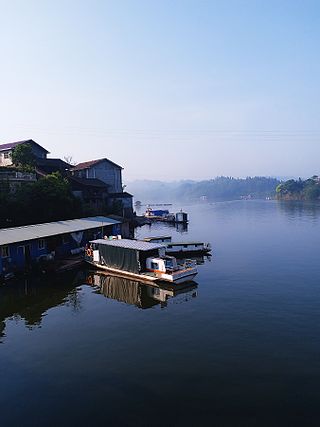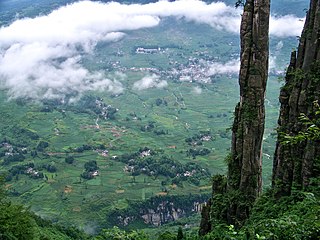
Pengshui Miao and Tujia Autonomous County is an autonomous county for the Miao and Tujia people located in southeastern Chongqing, China, bordering Guizhou province to the south and southwest and Hubei province to the northeast. It is 270 kilometres (170 mi) away from downtown Chongqing.
Jishou is a county-level city and the seat of Xiangxi Tujia and Miao Autonomous Prefecture, Hunan province, China.

Huaihua is a prefecture-level city in the southwest of Hunan province, China. It covers 27,564 km2 (10,643 sq mi) and is bordered by Xiangxi to the northwest, Zhangjiajie and Changde to the north, Yiyang, Loudi and Shaoyang to the east, Guilin and Liuzhou of Guangxi to the south, and Qiandongnan and Tongren of Guizhou to the southwest. It has a population of 4,741,948, accounting for 7.22% of the provincial population. According to the 2010 Census, 2,909,574 people, or 61.4% of the population, are Han Chinese. Minorities constitute 38.6% of the population, with 1,832,289 people. The Dong, Miao, Tujia, Yao and Bai are major native minority groups. Huaihua is the central region of the Dong ethnic population, home to nearly 28.35% of the Chinese Dong ethnic group.

Enshi Tujia and Miao Autonomous Prefecture is located in the mountainous southwestern corner of Hubei province, People's Republic of China. It forms Hubei's southwestern "panhandle", bordering on Hunan in the south and Chongqing Municipality in the west and northwest. The Yangtze River crosses the prefecture's northeastern corner in Badong County.
Longshan County is a county of Hunan Province, China, it is under the administration of Xiangxi Autonomous Prefecture.

Fenghuang County, named after the mythological birds Fenghuang, is a county of Hunan Province, China, under the administration of Xiangxi Autonomous Prefecture.
Luxi County is a county of Hunan Province, China. It is under the administration of Xiangxi Autonomous Prefecture.
Huayuan County is a county of Hunan Province, China, it is under the administration of Xiangxi Autonomous Prefecture.
Baojing County is a county of Hunan Province, China, it is under the administration of Xiangxi Autonomous Prefecture.
Guzhang County is a county of Hunan Province, China. The county is the 2nd least populous administrative unit of the counties or county-level cities in the province, it is under the administration of Xiangxi Autonomous Prefecture.

Yongshun County is a county of Hunan Province, China. It is under the administration of Xiangxi Autonomous Prefecture.

Waxiang is a divergent variety of Chinese, spoken by the Waxiang people, an unrecognized ethnic minority group in the northwestern part of Hunan province, China. Waxiang is a distinct language, and is very different from the surrounding Southwestern Mandarin, Xiang Chinese, and the Eastern Miao (Xong) languages.

Qianjiang District, formerly Qianjiang Tujia and Miao Autonomous County, is a district, in the southeastern part of Chongqing, China, bordering Hubei province to the east and northeast. While it is governed as a district, in practice Qianjiang is its own city proper far removed from the urban centre of Chongqing. Qianjiang is nicknamed "The Throat of Sichuan and Hubei" (川鄂咽喉) because it sits on the intersection of Sichuan-Hubei and Sichuan-Hunan Roads.
The Xong language is the northernmost Hmongic language, spoken in south-central China by around 0.9 million people. It is called Xiangxi Miaoyu in Chinese, as well as Eastern Miao (东部苗语). In Western sources, it has been called Meo, Red Miao, and North Hmongic. An official alphabet was adopted in 1956.
Xiangxi Biancheng Airport is an airport serving Xiangxi Tujia and Miao Autonomous Prefecture in Hunan Province, China. It is located in Huayuan County. The airport is a dual-use general aviation and commercial aviation airport.
The Waxiang people are an unrecognized ethnic group living along the Yuan River in Yuanling County of western Hunan, China. They call themselves Huaxiang people and they speak Waxiang Chinese. Compared to the Han, Miao and Tujia people of the region, they are different in terms of living style, farming and other cultural norms.
The Politics of Xiangxi Tujia and Miao Autonomous Prefecture in Hunan province in the People's Republic of China is structured in a dual party-government system like all other governing institutions in mainland China.
Long Xiaohua is a former Chinese politician of Miao ethicity who spent her entire career in her home-province Hunan. As of February 2023 she was under investigation by China's top anti-corruption agency. Previously she served as governor of Xiangxi Tujia and Miao Autonomous Prefecture.









